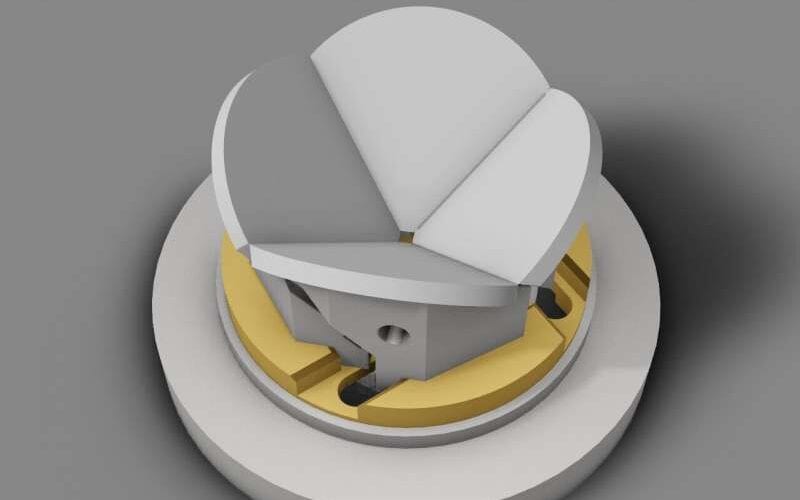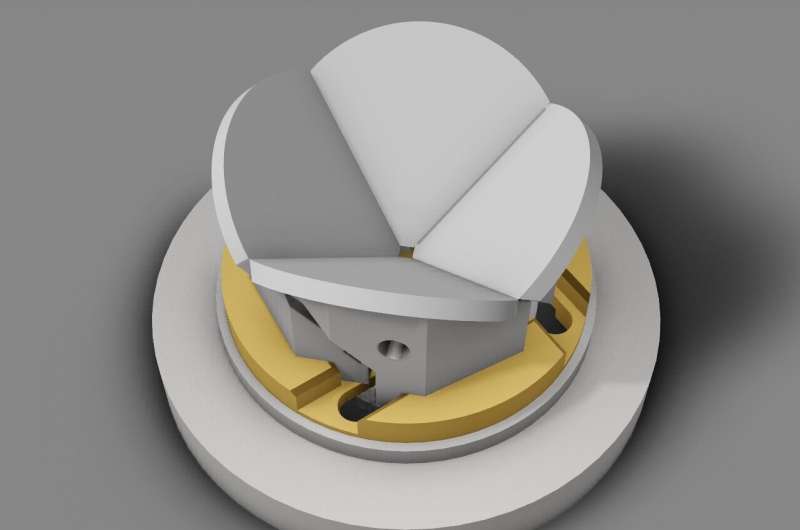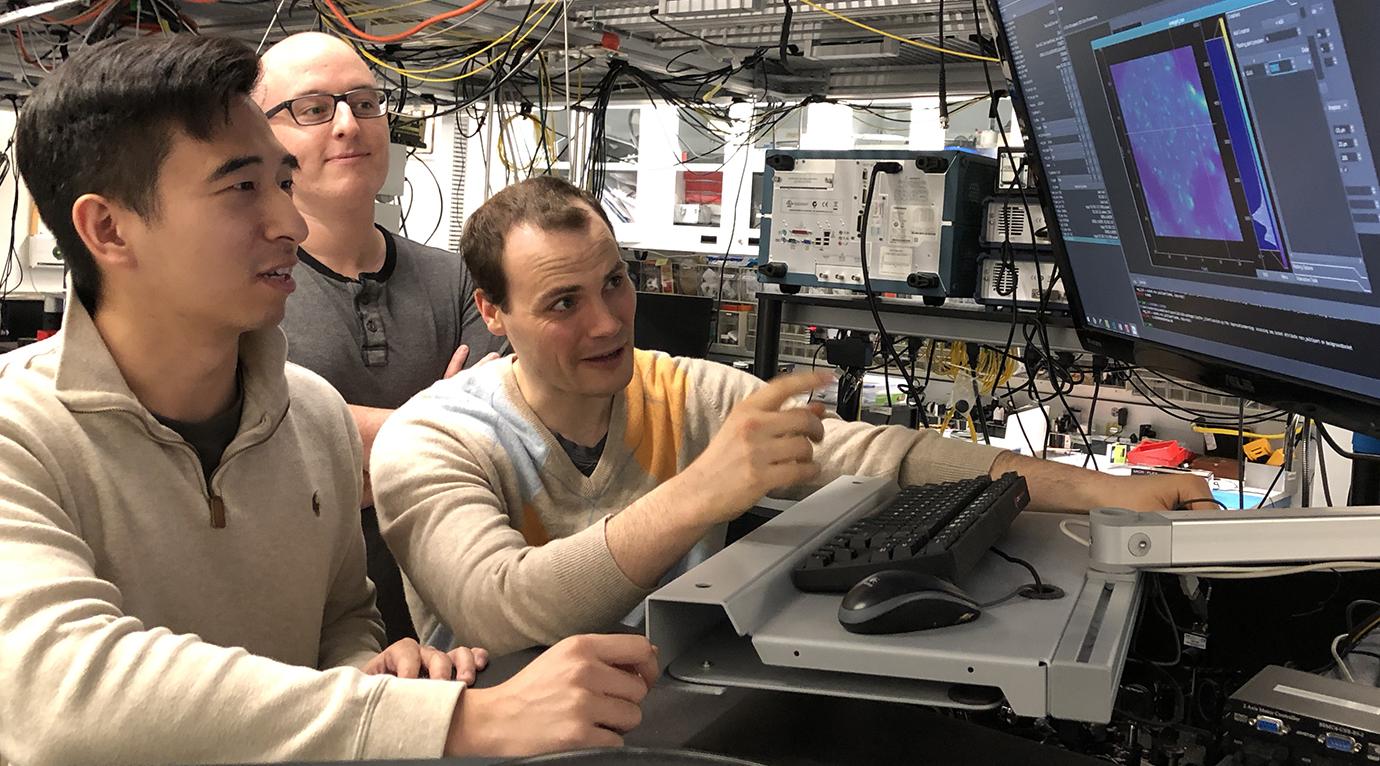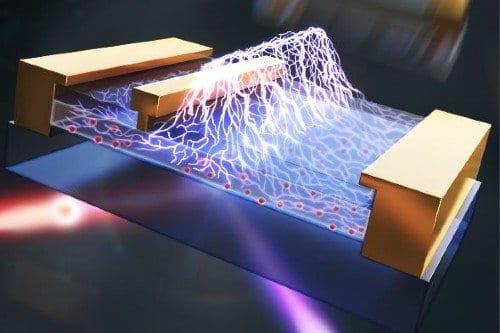
Researchers designed a cold atom source that uses four mirrors arranged like a pyramid and placed in a way that allows them to slide past each other like the petals of a flower. This creates an adjustable hole at the top of the pyramid through which the cold atoms are pushed out. This image show a rendering of the device.
Credit: Christopher Foot, Oxford University
Technology advance could enable space-based atomic clocks, improving communications and GPS navigation
Although quantum technology has proven valuable for highly precise timekeeping, making these technologies practical for use in a variety of environments is still a key challenge. In an important step toward portable quantum devices, researchers have developed a new high-flux and compact cold-atom source with low power consumption that can be a key component of many quantum technologies.
“The use of quantum technologies based on laser-cooled atoms has already led to the development of atomic clocks that are used for timekeeping on a national level,” said research team leader Christopher Foot from Oxford University in the U.K. “Precise clocks have many applications in the synchronization of electronic communications and navigation systems such as GPS. Compact atomic clocks that can be deployed more widely, including in space, provide resilience in communications networks because local clocks can maintain accurate timekeeping even if there is a network disruption.”
In The Optical Society (OSA) journal Optics Express, S. Ravenhall, B. Yuen and Foot describe work carried out in Oxford, U.K. to demonstrate a completely new design for a cold atom source. The new device is suitable for a wide range of cold-atom technologies.
“In this project we took a design we made for research purposes and developed it into a compact device,” said Foot. “In addition to timekeeping applications, compact cold-atom devices can also be used for instruments for gravity mapping, inertial navigation and communications and to study physical phenomena in research applications such as dark matter and gravitational waves.”
Cooling atoms with light
Although it may seem counterintuitive, laser light can be used to cool atoms to extremely low temperatures by exerting a force that slows the atoms down. This process can be used to create a cold-atom source that generates a beam of laser-cooled atoms directed toward a region where precision measurements for timekeeping or detecting gravitational waves, for example, are carried out.
Laser cooling usually requires a complicated arrangement of mirrors to shine light onto atoms in a vacuum from all directions. In the new work, the researchers created a completely different design that uses just four mirrors. These mirrors are arranged like a pyramid and placed in a way that allows them to slide past each other like the petals of a flower to create a hole at the top of the pyramid through which the cold atoms are pushed out. The size of this hole can be adjusted to optimize the flow of cold atoms for various applications. The pyramid arrangement reflects the light from a single incoming laser beam that enters the vacuum chamber through a single viewport, thus greatly simplifying the optics.
The mirrors, which are located inside the vacuum region of the cold-atom source, were created by polishing metal and applying a dielectric coating. “The adjustability of this design is an entirely new feature,” said Foot. “Creating a pyramid from four identical polished metal blocks simplifies the assembly, and it can be used without the adjustment mechanism.”
Better measurements with more atoms
To test their new cold-atom source design, the researchers constructed laboratory equipment to fully characterize the flux of atoms emitted through a hole at the apex of the pyramid.
“We demonstrated an exceptionally high flux of rubidium atoms,” said Foot. “Most cold-atom devices take measurements that improve with the number of atoms used. Sources with a higher flux can thus be used to improve measurement accuracy, boost the signal-to-noise ratio or help achieve larger measurement bandwidths.”
The researchers say that the new source is suitable for commercial application. Because it features a small number of components and few assembly steps, scaling up production to produce multiple copies would be straightforward.
Original Article: New Cold Atom Source Lays Groundwork for Portable Quantum Devices
More from: Oxford University | The Optical Society
The Latest Updates from Bing News & Google News
Go deeper with Bing News on:
Portable quantum devices
- Being in two places at once could make a quantum battery charge faster
The quantum principle of superposition – the idea of particles being in multiple places at once – could help make quantum batteries that charge within minutes ...
- Physicists Develop Groundbreaking Device for Advanced Quantum Computing
Researchers have made a significant advancement in quantum computing by adapting a microwave circulator to precisely control the nonreciprocity between a qubit and a resonant cavity. This innovation n ...
- quantum accelerometer
Right now, the current state of the art in portable sensors are MEMS devices, and you can get them for the cost of a hamburger. But if you want the ultimate in accuracy, you’ll want a quantum ...
- 1 Quantum Computing Stock with 141% Upside Potential
Rigetti’s Novera QPU manufacturing unit “Fab-1” is the industry’s very first dedicated and integrated quantum device manufacturing unit. Rigetti is set to release its 1Q results on May ...
- Quantum Computers News
Physicists Build New Device That Is Foundation for Quantum Computing May 1, 2024 — Scientists have adapted a device called a microwave circulator for use in quantum computers, allowing them for ...
Go deeper with Google Headlines on:
Portable quantum devices
[google_news title=”” keyword=”portable quantum devices” num_posts=”5″ blurb_length=”0″ show_thumb=”left”]
Go deeper with Bing News on:
Quantum devices
- Australia just made a billion-dollar bet on building the world’s first “useful” quantum computer in Brisbane. Will it pay off?
The Australian government has announced a pledge of approximately $940 million to PsiQuantum, a quantum computing start-up company based in Silicon ...
- Arqit warns CISOs why they must act now to secure their data ready for the post-quantum world
document number IDC #EUR252099724 Arqit Quantum Inc. (Nasdaq: ARQQ, ARQQW) (Arqit) supplies a unique encryption software service which makes the communications links of any networked device, cloud ...
- Quantum Computing Revolutionizes Energy, Agriculture, and Material Science
Quantum computing provides more novel and reliable ways to accelerate progress in mitigating climate change and does so faster than other known technologies. For instance, it can execute optimization ...
- PreSonus announces new Quantum Audio Interfaces
The all-new PreSonus interfaces will be available in four models: Quantum ES 2, Quantum ES 4, Quantum HD 2, and Quantum HD 8.
- PreSonus’s new Quantum audio interfaces feature inputs that were co-developed with Fender
In fact, the Quantum ES models come with six months of access to the Studio One+ subscription service, and the Quantum HD devices come with a year of Studio One+ Hybrid, which includes a perpetual ...
Go deeper with Google Headlines on:
Quantum devices
[google_news title=”” keyword=”quantum devices” num_posts=”5″ blurb_length=”0″ show_thumb=”left”]











